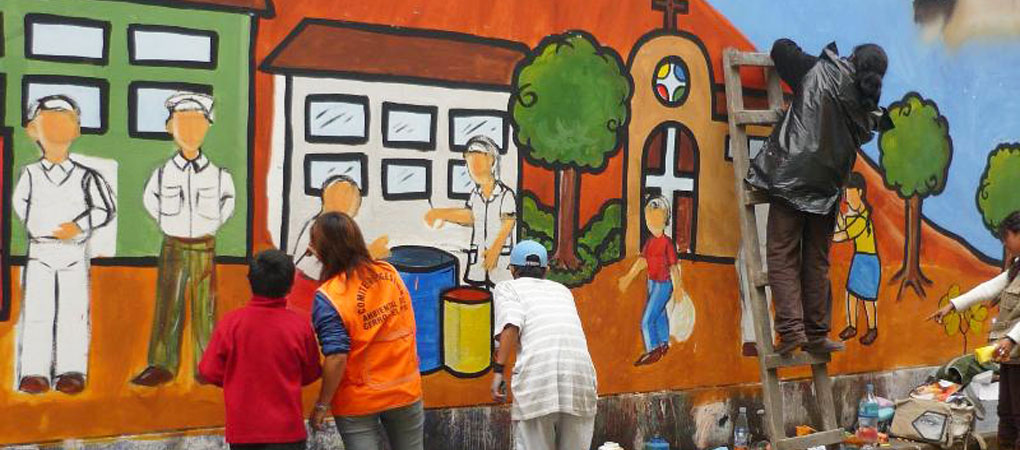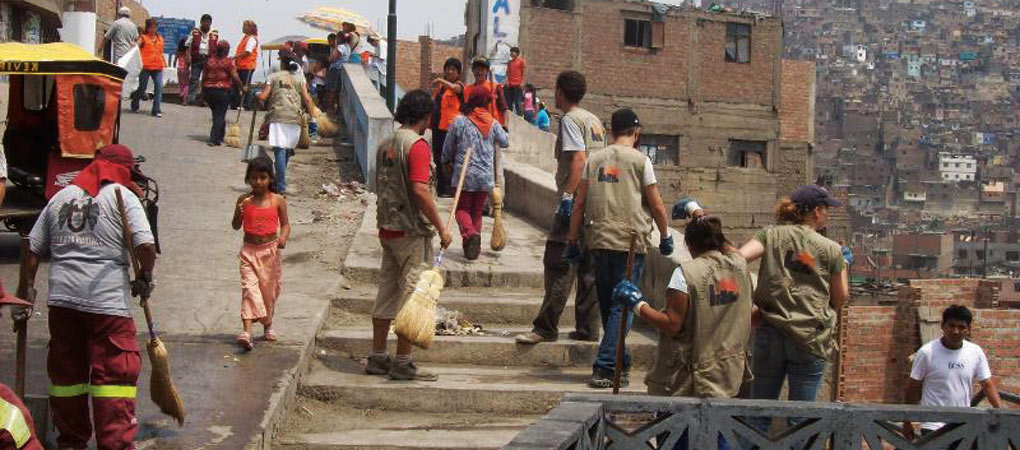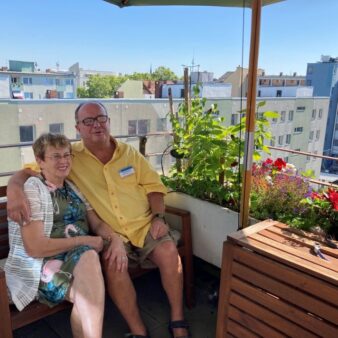Ciudad Saludable is a Peruvian non-governmental organisation, established in 2002 by a group of professionals to improve people’s quality of life through innovative environmental management systems. A community-based solid waste management project in Cerro el Pino innovatively uses motorbike as a means to access remote areas. This project triggers the creation of micro-enterprises and income generation opportunities for waste collectors and recyclers. The population including school students is taking part in the change of mentality by transferring the knowledge of rights and duties in the maintenance of a clean environment. A community-based monitoring system has been set up which oversees the work of the waste collection micro-enterprises. Residents have also been involved in the implementation and development of all project activities, including focus group discussions to address issues of environmental awareness, participate in cleaning campaigns, painting murals, service payments and separation of organic from inorganic waste in their homes.
Project Description
Aims and Objectives
The aim of the project is to develop an efficient solid waste management system for Cerro el Pino, reduce waste volume in streets and landfills while creating opportunities for income generation and contributing towards improved quality of life. The direct beneficiaries are the 23,450 residents of Cerro El Pino, including eight recyclers who have permanent jobs as members of the solid waste collection micro-enterprise. Indirect beneficiaries (an estimated 120,000 people) include vendors and consumers at the largest fruit market of Lima, which is located next to Cerro El Pino.
Context
The project is located in the Cerro El Pino informal settlement of the La Victoria district, with a population of over 23,000 people, 79 per cent of which is under 40 years of age. One of the major problems in the area is related to solid waste: no waste collection services are provided by the local municipality and approximately 13 tonnes of solid waste generated daily are thrown into open dumps. As a result, the residents of the area, particularly children and older people, suffer from health problems. The terrain is steep and access roads are narrow, making it impossible for conventional waste collection vehicles to enter the settlement. Moto-car is the common means of transport, with steep stairways for pedestrian circulation. Rates of crime and unemployment are high and the area had a reputation for being dirty and unsafe.
Key features
Ciudad Saludable has developed an innovative community-based solid waste management programme in collaboration with the local government as well as a range of CBOs from the Cerro del Pino informal settlement. Initiated in 2007, the key components of the programme include:
- Strengthening social networks and establishing a Committee for Local Environmental Management: the role of the Committee is to manage, control, and monitor the cleaning service programme; collect service fees from households, participate in awareness campaigns and coordinate with the municipality for continuous service improvement.
- Establishing a micro-enterprise within the community to provide a non-conventional system of solid waste collection through motorbikes (known as Moto vans); processing of organic waste and recycling services using low-cost, non-conventional technologies; generating formal employment for residents already working in the informal recycling of solid waste as well as those – particularly young people – who are unemployed.
- Organisation of a system for door-to-door collection of weekly, fortnightly or monthly payments for the services provided, according to the preference and economic possibilities of each family.
- Raising public awareness of environmental and health issues (i.e. in schools, workshops, campaigns, etc).
Most residents had never received, nor paid for, waste collection services, and the programme has therefore been implemented in two phases, the first of which involved residents providing their waste to the waste-collection motorbike. By August 2009, 80 per cent of residents were doing this and 53 per cent (800 families) were paying for the service. The second phase, which has recently started, involves the separation of solid waste at household level. Currently 20 per cent of households separate their waste. These figures have been gradually increasing as residents become more aware of the benefits and importance of the programme and learn more about environmental issues affecting their community.
Covering costs
The capital costs to implement the project were US$77,454 (€52,945), covering equipment costs, human resources, travel and accommodation, operations, supplies and other indirect costs. Funding is provided by the Council of Barcelona and CODESPA Foundation. The ongoing revenue costs of US$2,100 per month include human resources, fuel and vehicle maintenance and are covered by residents’ payment for the services (US$1.40 per month per household, with approximately 1,500 households able to pay for the service). The municipal government covers ongoing transportation and final disposal costs, as well as contributing towards operating costs until all residents are paying for the services.

Impact
- The project has significantly improved the quality of life of residents, with a substantial reduction in health problems and health-related costs. Local markets have benefited and residents report their satisfaction with the clean environment.
- The community-managed system has empowered residents and led to a strong sense of ownership. An increasing number of residents have begun to develop new habits and apply techniques to reduce, reuse and recycle waste.
- The community has mobilised around other environmental issues such as reforestation and improvement of public spaces.
Why is it innovative?
- Community empowerment through the establishment of a solid waste management committee (the Committee for Local Environmental Management, who manages the solid waste collection service, the separation and commercialisation of recyclable waste and the collection of payments) as well as transparency in managing public funds.
- Use of non-conventional technologies, i.e. motorbikes, which are accessible to the steep terrain and narrow streets.
- Active participation of residents and community-based organisations throughout the process.
- Creation of income generation opportunities through an innovative micro-enterprise model (e.g. collection services, processing of organic waste and managing of manual sanitary landfills).
- Gender equity through women’s leadership in the management of solid waste.
- Development of partnerships with local schools to help raise awareness of environmental issues.
What is the environmental impact?
- The project does not involve the use of building materials for housing construction. Whilst the Cerro El Pino project does not specifically work to provide or ensure the appropriate use of energy and water resources, the work of Ciudad Saludable generally involves the promotion of clean technologies, such as bio-digesters to produce biogas, and energy-efficient, eco-friendly offices.
- The project has led to waste collection of 10.5 tons per day, representing 80 per cent of the waste generated in Cerro El Pino. This waste does not end up in public areas and thus reduces health risks.
- An average of 3.5 tons of recyclable waste is collected per month, reducing transportation costs and disposal of waste.
- There has been recovery of public space for green areas and reforestation of land that used to be a dump.
- Awareness of environmental issues has gradually increased within the settlement and 20 per cent of residents currently separate their waste for recycling.
Is it financially sustainable?
The capital funding for project from the Council of Barcelona and CODESPA Foundation will continue until March 2010, after which all ongoing running costs for the project will be covered entirely by residents who pay for the services, with the municipal government covering transportation and final disposal costs.
- Eight permanent jobs have been generated for local residents, who previously worked as informal waste pickers, with the establishment of a waste collection micro-enterprise. Their wages (US$210 per month) are covered by residents’ payments for services and additional income is generated through their recycling activities. In its work to date, Ciudad Saludable has established 35 micro-enterprises including nurseries, humus and organic fertiliser plants, recycling paper companies and landfills, creating permanent employment for 320 people in 20 cities and benefiting three million people.
- The clean-up of Cerro El Pino has also increased the incomes of local merchants, since in the past the accumulation of waste – and accompanying cockroaches, rats, flies etc drove away potential customers.
- There has been a reduction in health-related costs to households as a result of preventing diseases linked directly to waste disposal in open dumps. There is also an increase in property values as a result of the reduced waste.
- The costs of the waste collection services are affordable to families, at just US$1.40 per month per household.
- Previously, the narrow streets and stairways were littered with waste and it was difficult for residents to reach their homes. The clean streets, stairways and gardens have improved pedestrian accessibility within the settlement.
What is the social impact?
- The working relationship between the community and the municipality government moved from confrontation to cooperation. An agreement has been signed and a system has been created that today is led by residents, in partnership with municipal authorities. Two cleaning campaigns have since been jointly run in the settlement.
- Four spaces that used to be painted with pictures and messages that promoted violence have been restored and painted collectively by community members to show themes of unity, solidarity and environmental responsibility.
- The community and schools have come together to celebrate World Environment Day with a fair and a parade.
- Members of the Committee for Local Environmental Management have been trained in management processes.
- Ten local volunteers have been trained and have formed an Environmental Awareness Team.
- Eight waste collectors have been trained in solid waste management, business management and customer service.
- In three local schools, teachers have been trained in environmental education programmes to carry out with students.
- In the wider sphere, Ciudad Saludable has published many books, manuals and guides on solid waste management and has trained over 5,000 teachers across the country and raised awareness among more than five million people.
- Reported incidences of respiratory and digestive health problems have significantly decreased since the project was implemented, with an associated reduction in health-related costs to families.
- The project works to achieve the social and economic inclusion of the most marginalised individuals and families.
- Women and young people in particular have been actively involved in the project and a community based organisation of mothers in Cerro el Pino is one of the active members of the Committee for Local Environmental Management.
- Previous municipal administrations had failed to address the problem. The community has come together to address the issue, forming its own self-managed system and negotiating with the local government, who is now involved.
- The community-based monitoring system oversees the work of the waste collection micro-enterprise at 21 checkpoints.
- Members of the grassroots organisations represented in the management committee are democratically elected.
- Ciudad Saludable has promoted the formation of the National Movement of Recyclers, of which the micro-enterprise of Cerro el Pino is an active member, and has worked with leaders to strengthen the movement.
Barriers
- There was initial resistance from residents to paying for the waste collection service and separating organic from inorganic waste in their homes. The Environmental Committee was therefore set up in partnership with well-respected organisations within the community, who could reach out to residents and persuade them to get involved in the project.
- Prior to the project, motorcycles that provided public transportation services would carry garbage bags from residents for a fee and dispose of the waste at the edge of the slum or surrounding streets. Community meetings were held with representatives of these groups, ensuring their cooperation in stopping this practice of dumping waste.
- There was initial resistance from local authorities to delegate tasks to the community to implement a waste collection system managed by the community. The Solid Waste Act, however, supports public participation in the management of solid waste and the Environmental Committee negotiated with city officials to ensure a cooperative working relationship.
- There was a lack of municipal collection vehicles for the transfer of waste from the motorbikes. The micro-enterprise therefore decided to synchronise its activities with the schedules of vehicles providing the service in nearby areas.
- The lack of environmental knowledge of the population is being addressed through awareness-raising campaigns.
Lessons Learned
- Ensuring the direct involvement of local groups and organisations makes it possible to reach the population more rapidly and effectively. These community organisations also provide credibility to the social development process.
- Empowering communities and raising awareness of their rights and obligations enables them to enter into dialogue and negotiation with local government, establishing lasting agreements and building trust.
- Schools play an important role in the process, as children go on to become the promoters of change in their community.
- The participation of residents and grassroots organisations ensures transparency and keeps political interests in check.
Evaluation
The project is ongoing and the community-managed solid waste management system is up and running. Future plans include working to continue to raise awareness and increase participation in payment for services and recycling of waste. Reported incidences of respiratory and digestive health problems have significantly decreased since the project was implemented, with an associated reduction in health-related costs to families. There is a control system implemented by the community to audit the services being provided. In each of the 21 sectors in Cerro El Pino, there is a resident who controls the waste collection service by verifying compliance frequency, schedule, quality, feedback and complaints from neighbours and other issues related to the waste collection service.
Transfer
Since Ciudad Saludable began its activities in 2002, sixty districts in the country have implemented comprehensive environmental solid waste management systems. The organization is also currently developing country studies on the socioeconomic situation of recyclers and other waste management stakeholders in Peru, Chile, Ecuador and Bolivia.The Cerro El Pino project allowed Ciudad Saludable to validate the use of motorbikes for the collection of solid waste. The approach has been transferred through the incorporation of these vehicles and community management structures in other collection systems in the cities of San Juan Bautista – Loreto, where services are provided to 85,000 people with a similar technology, and the city of Pucallpa which serves 40,000 people in Lima through the selective collection of waste from the business sector with the use of similar vehicles. The Ciudad Saludable community management model has been transferred to communities in Venezuela (Jusepin/Maturin), Mexico (Queretaro), Bolivia (Santa Cruz) and Brazil (Goiânia).
Partnership
CBO, Local government, Academic/Research



